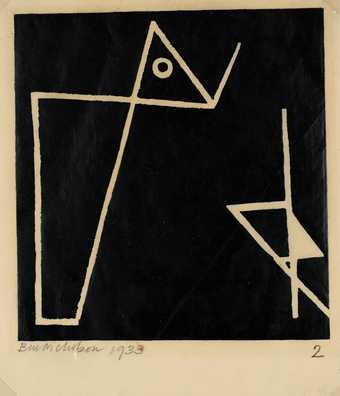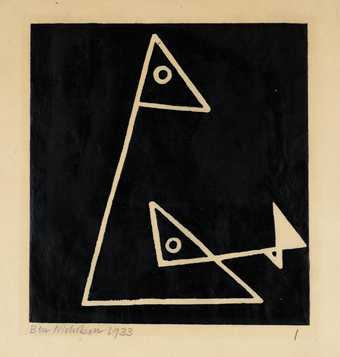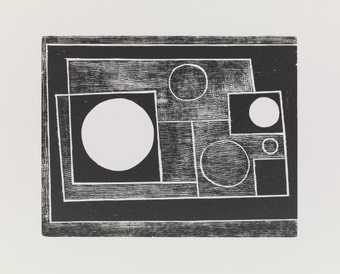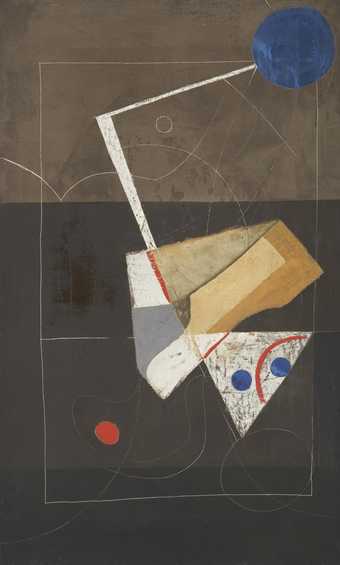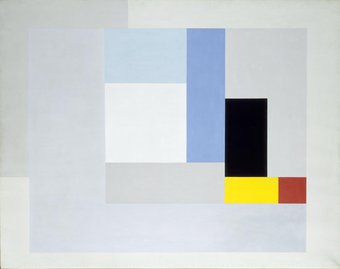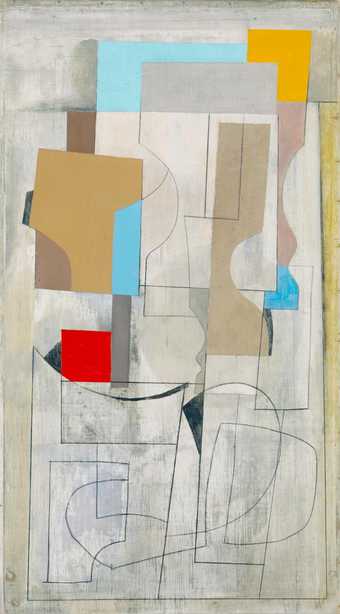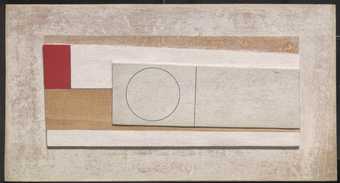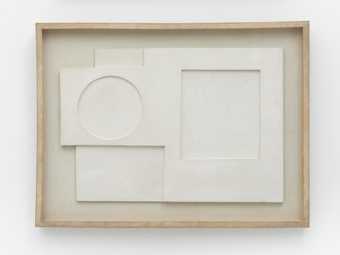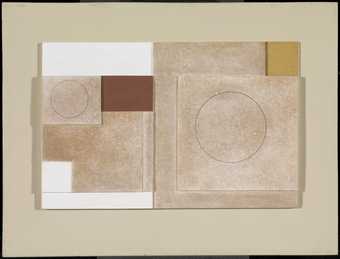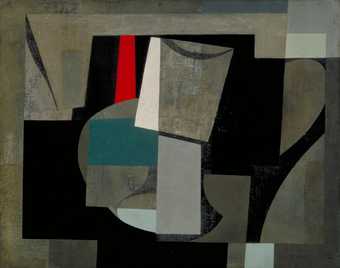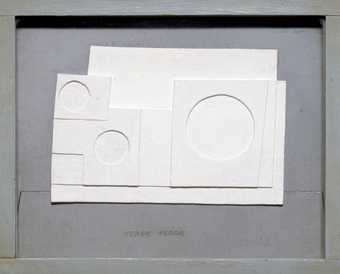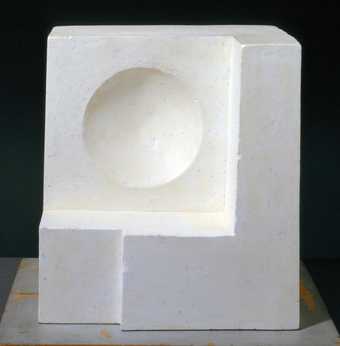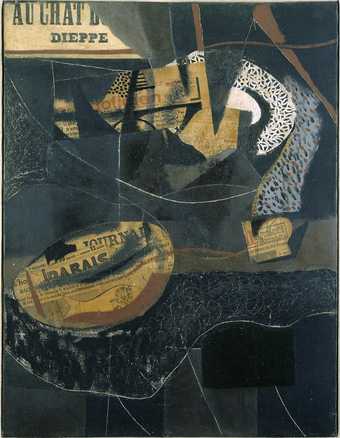Not on display
- Artist
- Ben Nicholson OM 1894–1982
- Medium
- Painted wood
- Dimensions
- Object: 228 × 305 × 241 mm
- Collection
- Tate
- Acquisition
- Purchased 1985
- Reference
- T04119
Summary
This work, c.1936 (sculpture), is one of two sculptures by Nicholson in the Tate's collection. Made from a block of hardwood, it was created by a combination of sawing, sanding and planing. All the faces have been painted white with the exception of the underside, which remains in its natural state. The second sculpture (Tate Gallery T07274) is carved from a block of plaster.
Nicholson's practice of carving reliefs led him naturally to explore the possibility of making sculpture, which he was encouraged to do while sharing a studio with his second wife, the sculptor Barbara Hepworth. He wrote to his estranged wife, the artist Winifred Nicholson, on 24 February [?1936] that he had just made his first sculpture 'which feels pretty exciting I can tell you ... It is cut out of mahogany & painted white. Tomorrow I am going to hunt for some chunks of wood ... Cutting wood is easy & the free movement & quickness of the whole thing is refreshing after the tremendous & meticulous concentration of the new ptg.' (quoted in Lewison, p.221). These remarks were accompanied by a sketch of a sculpture which is now lost, probably destroyed. c.1936 (sculpture) was probably made in March, for on 13 March 1936 Nicholson wrote to Winifred that he had made four sculptures, two in wood and two in plaster.
Nicholson's sculptures differ significantly from his reliefs in their emphasis on architectural qualities. His hardwood piece resembles buildings of the period, while the plaster work in the Tate collection is suggestive of a wall. The sculptures were made at the same time that Nicholson was collaborating with Leslie Martin and Naum Gabo in the production of their intended periodical Circle: International Survey of Constructive Art (1937), in which painting and sculpture were united with architecture. The planar quality of c.1936 (sculpture), however, also relates to the work of artists associated with the de Stijl movement, for example, Georges Vantongerloo.
This piece was given by Nicholson to the sculptor Dennis Mitchell, Barbara Hepworth's assistant, when Nicholson moved from Carbis Bay to St Ives in 1943. It was spotted by Mitchell when Nicholson was clearing out the outhouse and he expressed a liking for it, whereupon Nicholson offered it to him. Nicholson told Mitchell he had put it away because, on completing it, he had shown it to Hepworth 'who had laughed at it'. Nicholson gave the work to Mitchell telling him he could make his own sculpture from the block if he wished. Mitchell, however, decided to preserve it.
Further reading:
The Tate Gallery 1984-86: Illustrated Catalogue of Acquisitions, Tate Gallery, London 1988, pp.223-4, reproduced
Jeremy Lewison, Ben Nicholson,
exhibition catalogue, Tate Gallery, London 1993, p.221, reproduced
Terry Riggs
January 1998
Does this text contain inaccurate information or language that you feel we should improve or change? We would like to hear from you.
Display caption
Nicholson’s interest in the ability of a work of art to create space led him to make reliefs and a small number of sculptures. This piece was made from a block of mahogany that Nicholson sawed, planed, sanded and painted white. The way it projects out into the space around it recalls the modernist architecture of the period. In a letter to his estranged wife Winifred, Nicholson wrote: ‘Cutting wood is easy & the free movement & quickness of the whole thing is refreshing after the tremendous & meticulous concentration of the new ptg’.
Gallery label, October 2012
Does this text contain inaccurate information or language that you feel we should improve or change? We would like to hear from you.
Catalogue entry
Ben Nicholson O.M. 1894-1982
T04119 sculpture
c.1936
Painted wood 228 x 305 x 241 (9 x 12 x 9 1/2)
Inscribed on underside ‘Ben Nicholson 193[...]-3[...]' towards t.l., ‘[symbol comprising an equilateral triangle above an 'equals' sign] 3 Mall Studio Parkhill Road London NW3>' b.l., ‘To | Nicholson | Chy an Kerris | CARBIS BAY | CORNWALL' circumscribed by a pencil line vertically on right and ‘BOTTOM' diagonally towards top centre
Purchased from Waddington Galleries (Grant-in-Aid) 1985
Prov: Given by the artist to Dennis Mitchell 1943 by whom sold to Waddington Galleries 1983
Exh: Groups VII, Waddington Galleries, Jan. 1984 (96, repr. p.53, as ‘Untitled 1930s'); Modern British Sculpture: From the Collection, Tate Gallery Liverpool, Sept. 1988-1991 (no number, repr.)
Lit: Tate Gallery Report 1984-6, 1986, p.76 repr.
T04119 is one of only two known sculptures by Ben Nicholson. The other sculpture, which is in a private collection, is made of plaster and is reminiscent of a wall relief (repr. Jeremy Lewison (ed.), Ben Nicholson: The Years of Experiment 1919-39, exh. cat., Kettle's Yard Gallery, Cambridge 1983, p.77). T04119 is made from a mahogany block and is reminiscent of modernist architecture. It was created by a combination of sawing, sanding and planing. Although the surface is reasonably smooth it is pitted in certain areas. One corner has been damaged, possibly when it was stored by the artist in an outhouse. All the faces have been painted white with the exception of the underside which remains in its natural state.
Nicholson began to carve reliefs in 1933. These were intended to be hung on the wall. Nevertheless their three-dimensional quality was of particular interest. The earliest reliefs were painted in different colours, generally in the darker range, but in 1934 Nicholson began to make reliefs which were all white. The change from painting to carving was described by Nicholson as arising from an accident which occurred when working on a painting in Paris (see Charles Harrison, ‘Notes on Ben Nicholson and Commentary on Selected Works' in Ben Nicholson, exh. cat., Tate Gallery, 1969, p.28). A piece of gesso fell away from the surface at the intersection of two lines and Nicholson began to exploit the accident. Apart from the circumstances of this occasion, Nicholson must also have been encouraged to carve into the surface of his paintings by his experience in making linocuts, by the stimulation provided by the sculptors Barbara Hepworth, with whom he shared a studio from 1932, and Henry Moore, who was a neighbour, and by his evident pleasure in engaging physically with materials. Even in the earlier two dimensional works Nicholson would incise the paint surface with sharp instruments and continually scrape and rub it down. The creation of two sculptures should be seen as a development of the three-dimensional reliefs, even though the former are free standing. In addition, Nicholson had painted a number of boxes in the early thirties, as well as some items of furniture for his children, and had carved reliefs into at least two boxes in 1933 and 1934, the later example being painted white (both in private collections, London, the latter repr. Tate Gallery exh. cat. 1969, p.30)
The earliest reliefs contained circles that were freely drawn but by 1934 Nicholson began to plot the configurations of the reliefs with greater accuracy. As he stated in an article in Horizon
in October 1941, ‘later I valued more the direct contact that could be obtained by flat planes of colour made and controlled to an exact pitch and the greater tension obtainable by the use of true circles and rectangles' (‘Notes on Abstract Art', Horizon, vol.4, Oct. 1941, pp.274-5). The first such paintings (as opposed to reliefs) were executed in 1935 (see for example ‘Painting' 1935 repr. Lewison 1983, p.31 in col.). T04119 has very regular planes and for this reason must have been made sometime after 1934. However, it seems likely to have been made later in the decade since the reliefs most closely related to it are ‘Painted Relief' 1940 (private collection, repr. Herbert Read, Ben Nicholson: Paintings, Reliefs, Drawings, 1948, no.114) and ‘White Relief' 1938 (repr. ibid., no.130). Since T04119 is signed and dated in such a manner as to make it certainly a work of the thirties, and since the other known sculpture is dated by the artist to 1936, it is likely that T04119 was made around the same time.
The strongly architectural nature of this sculpture recalls Nicholson's collaboration with Leslie Martin and Naum Gabo in the production of Circle: International Survey of Constructive Art
(1937), in which painting and sculpture were united with architecture in a book which was to have been a periodical, but which was never published beyond the first issue. According to Jake Nicholson, the artist's son, Nicholson was very interested in modern architecture and when he visited his family in Paris in the thirties he would always take them to see new modernist buildings (conversation with the compiler). In addition, Nicholson lived in Hampstead in the road parallel to Lawn Road, where Wells Coates built a block of flats (1930), and a short distance from Highgate where the architectural practice, under the name of Lubetkin & Tecton, built the influential Highpoint I 1933-5. Both of these projects were of considerable architectural importance in Britain. Wells Coates had been a member, with Nicholson, of the short-lived Unit One.
The planar quality of T04119, however, also relates to the work of de Stijl artists and, in particular, to such works as Vantongerloo's ‘Interrelation of Volumes' 1919 (T02306), although Nicholson would not have seen this particular work. The latter is, in any case, more complex in its planar relationships.
T04119 was given by the artist to the sculptor Dennis Mitchell, Barbara Hepworth's assistant, when Nicholson was on the point of moving from Carbis Bay to St Ives in 1943. It was spotted by Mitchell when Nicholson was clearing out the outhouse and he expressed a liking for it, whereupon Nicholson offered it to him informing him that he, Nicholson, had put it away because, on completing it, he had shown it to Hepworth ‘who had laughed at it' (conversation between Dennis Mitchell and the compiler on 19 May 1988). Nicholson gave the work to Mitchell stating that he may use the block to make his own sculpture. Mitchell, however, decided to preserve it. When it was acquired by the Tate Gallery the sculpture had a greenish hue which was the product of bronze dust from Mitchell's studio where it was kept. T04119 has now been cleaned so that it is once again white.
Published in:
The Tate Gallery 1984-86: Illustrated Catalogue of Acquisitions Including Supplement to Catalogue of Acquisitions 1982-84, Tate Gallery, London 1988, pp.223-4
Explore
- abstraction(8,615)
-
- non-representational(6,161)
-
- geometric(3,072)
- monochromatic(722)
- periods and styles(5,198)
-
- modernist(155)
- formal qualities(12,454)
-
- space(177)
You might like
-
Ben Nicholson OM Foxy and Frankie (2)
1933 -
Ben Nicholson OM Foxy and Frankie (1)
1933 -
Ben Nicholson OM abstract
1934 -
Ben Nicholson OM 1933 (milk and plain chocolate)
1933 -
Ben Nicholson OM 1935 (white relief)
1935 -
Ben Nicholson OM June 1937 (painting)
1937 -
Ben Nicholson OM Feb 28-53 (vertical seconds)
1953 -
Ben Nicholson OM Dec 10-54
1954 -
Ben Nicholson OM 1934 (relief)
1934 -
Ben Nicholson OM 1939-44 (painted relief)
1939–44 -
Ben Nicholson OM 1934-6 (painting - still life)
1934–6 -
Ben Nicholson OM 1934 project for Massine for Beethoven 7th Symphony Ballet
1934 -
Ben Nicholson OM 1936 (white relief sculpture - version 1)
1936 -
Ben Nicholson OM Jan 27 1933
1933


